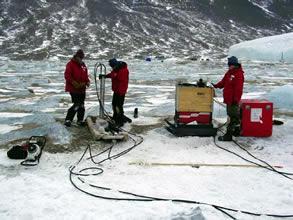
The MCM lakes program is focused on understanding the ecosystem structure and function of the microbe-dominated lakes in the McMurdo Dry Valleys, where few metazoans exist within the water columns. Specifically, this project collects long-term data on the physical and chemical conditions within the lakes and relates them to biological diversity and rate processes. The lakes, being the terminus of the hydrological continuum in the MCM, are reservoirs of history and are the only environments within the study site that contain liquid water and support metabolic activity throughout the year. Temporal data on lake level, ice thickness, and PAR closely reflect changes in climate and associated hydrology within the study area. The nonturbulent nature of the perennially ice-covered lakes in the dry valleys restricts mixing of nutrients to diffusion processes. Pelagic lake investigations examined organic carbon transformations between phytoplankton and bacterioplankton, the influence of nutrient input via streams on phytoplankton productivity, and determine primary loss rates for the phytoplankton (e.g., respiration, sinking). Paleolimnological studies are being conducted to put present lake environments into historical perspective, tracing environmental changes through recent time using lake bottom experiments. We aim to confirm and expand this record by using paleolake sediments left by lake stands (e.g., Glacial Lake Washburn), as well as investigate new dating techniques to refine temporal control.
